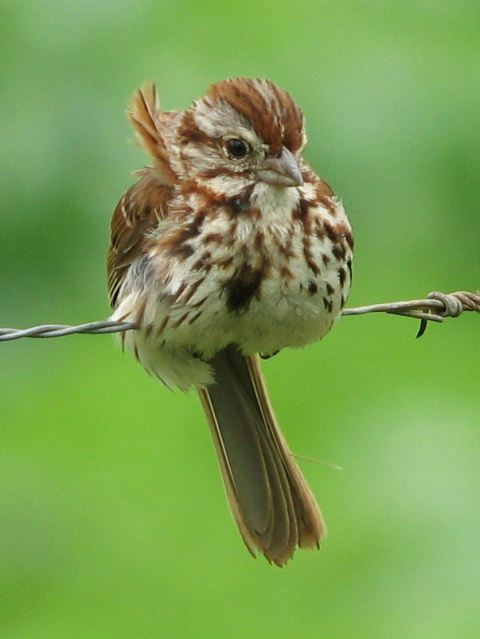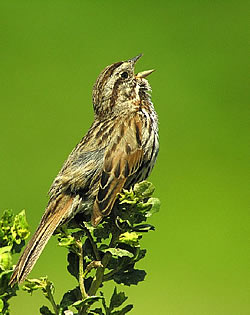
One of the brightest early arrivals at our farm is the song sparrow. His song, along with greening fields, red maples in flower, killdeer cries, and even robins singing at 4:30 in the morning are welcome signs of spring each year.
These little brown-streaked birds turn up as early as the last week of March and have fully established their territory by the second week of April.
Varied Songs
The male song sparrow announces his arrival near our garden with a cheerful song consisting of three or four clear, loud notes, followed by a trill and ending in a series of short notes. It might be interpreted as "hip, hip, hip hurrah boys! Spring is here!" or "maids, maids, maids, put the tea-kettle-ettle, ettle on."
We have at least four male song sparrows claiming their territories from a thorn apple branch, a willow bush, the garden fence post, or a brush pile. Each one has a different song, but all four start with the clear notes before they follow with a variation of the main theme.
Their songs are constant from early morning until evening dusk. I heard one singing before dawn the other day just as that persistent robin started its daily 4:30 a.m. "chirrups."

Well into Summer
Song sparrows sing well into summer while raising two, occasionally three, broods of young. Their rather bulky nests of grass stems and leaves lined with softer grass are usually built on the ground or low in a tangle of bushes or brambles. Last year a pair of sparrows nested in the fence row beside our farm garden, only two feet from the ground.
By August only the introductory notes may be heard, almost as if it could not be bothered to finish. But, as the days get colder I once again hear the familiar notes of the entire song as the sparrows prepare to leave for warmer climes. It is as though the little birds are reaffirming that they will return to that same spot next March.
Widely Distributed
The song sparrow, "Melorpiza melodia," is abundantly distributed throughout most of Canada and the U.S. The thirty-one subspecies vary widely in color and size. Our songster is about 6 1/2 inches long and, at first glance, seems similar to any of those little brown birds.
However, on closer observation it is easily identified by the heavy streaks on its breast which appear to converge in a dark central spot on the breast just under the throat. Also note its habit of pumping its tail when in flight.
The song sparrow's food, like most finches, is predominantly vegetable material, largely seeds. During breeding season they search for insects, such as cutworms, army worms, cabbage worms, locust, grasshoppers, and canker worms to feed to their young.

Sparrow Folklore
According to Laura C. Martin in "The Folklore of Birds," many ancient peoples believed that sparrows sprang from horsehair and mud. Superstition holds that the sparrow guards fire for the devil and chases the swallow who steals the fire and takes it to man.
The genus name "Melopiza" is from the Greek words melos, meaning "song," and spiza, meaning "finch." The male sparrow is said to have as many as twenty different melodies.
Laura Martin tells about the belief that if the sparrow chirps with exceptional enthusiasm, it is a sign that it will rain soon. The Chinese considered the sparrow a supernatural messenger and a foreteller of good luck. In Japan, a sparrow pictured under a maple tree was a symbol of gentleness, gratitude and joy.
The sparrow is a Hindu symbol of fruitfulness and fertility; and in Rome, the sparrow was sacred to Venus.
Song sparrow is not only a welcome harbinger of spring, but also a friendly backyard resident that keeps us entertained all summer long.
Samet Bilir writes about the gardening, interior design, holiday shopping and a lot of other things, such as artificial Christmas trees. To read more articles from him visit his website here.




No comments:
Post a Comment